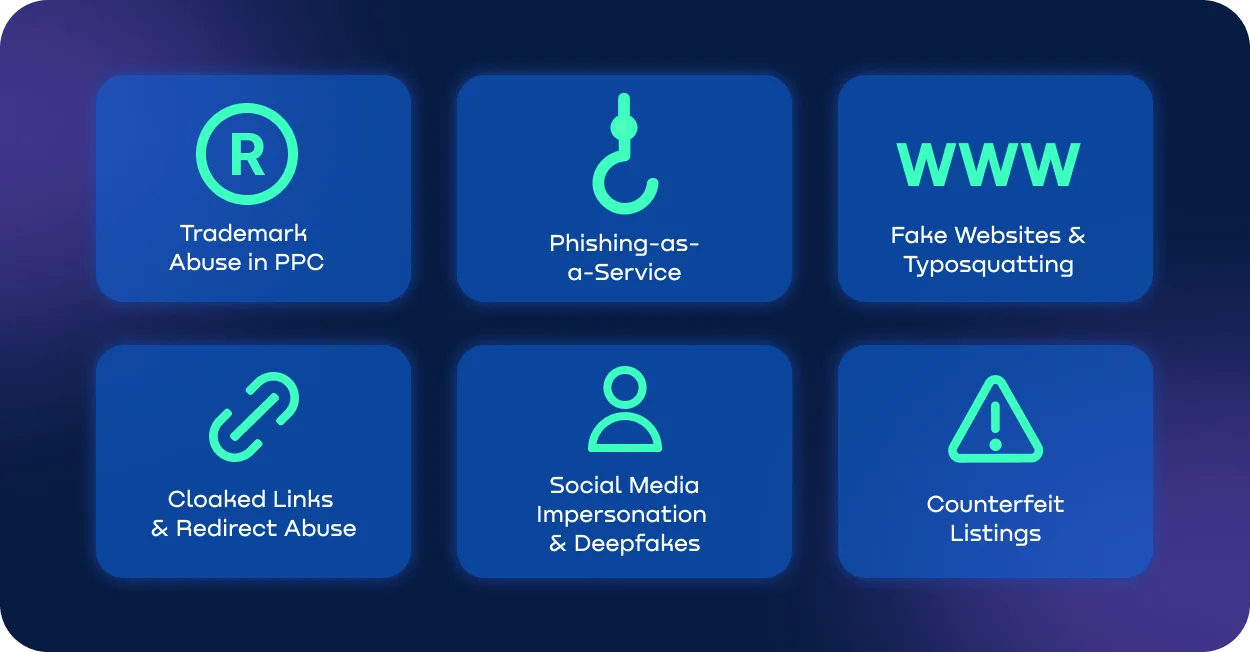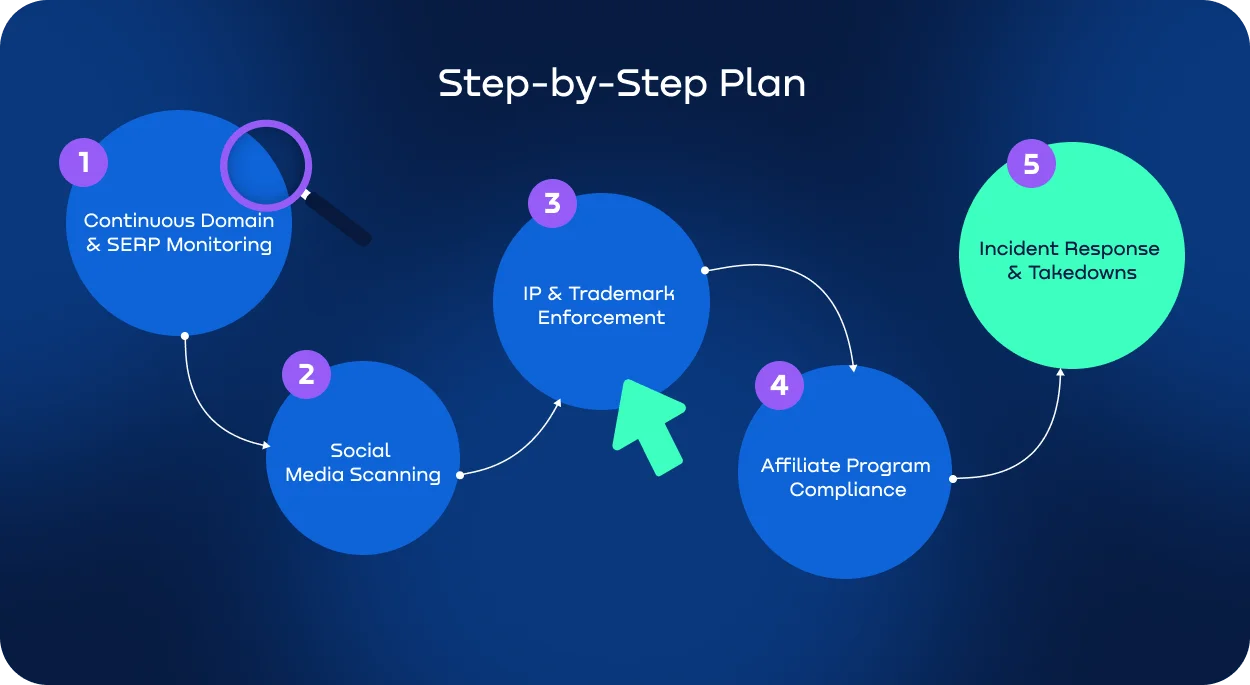
Contents
Today, fraudsters often have better tools than the brands they target. While many companies still rely on basic monitoring or slow legal action, fraudsters operate with automation, ad networks, and an endless list of domains.
71.6% of buyers unknowingly purchase fakes – up from 50% in 2023 (2025 State of Brand Protection). Fraudsters exploit this blind spot: they sell counterfeit under your brand, hijack your PPC ads, and cloak affiliate links.
This imbalance is why traditional brand protection no longer works on its own. Modern threats move too fast, adapt too easily, and hide too well for outdated methods to keep up.
Without knowing how to protect a brand online, even strong businesses risk losing traffic, revenue, and customer trust.
What Is Digital Brand Protection?
Digital brand protection is the practice of identifying, preventing, and removing online activities that misuse your brand name, logo, or reputation. Now, online threats are faster, harder to trace, and often invisible to the public until the damage is done.
The core goals of a brand protection strategy:
-
• Safeguarding reputation. Ensuring customers only interact with genuine brand assets.
-
• Protecting intellectual property. Preventing unauthorized use of brand names, logos, and content.
-
• Securing search visibility. Defending branded keywords from hijacking in paid and organic results.
-
• Ensuring affiliate compliance. Monitoring partner programs for cloaking and unauthorised redirects.
Digital brand protection has moved far beyond chasing down trademark violations. It’s now a critical marketing function, as scammers use advanced tools to mass-produce fake sites, hijack PPC campaigns, and exploit affiliate channels - all eroding your hard-earned brand equity.
Automated scripts can clone a website in minutes. AI tools can create convincing phishing pages and fake ads with your branded keywords. Paid search hijackers can run GEO targeted ads that steal your traffic before you even know they exist.
To counter this, brands need real-time detection, fast takedowns, and a brand protection strategy that will keep them visible and trusted.
Modern Threats to Digital Brand Protection
Brand security problems aren’t limited to the occasional fake profile or phishing email. Here are some of the most common tactics fraudsters rely on:
Fake websites & typosquatting. Without digital brand protection, fraudsters register domains almost identical to the original, replacing letters or adding small changes. For example, they can launch an “amaz0n-support.com” clone of Amazon’s login to steal customer data or process fake payments.
Bluepear identifies fake websites that impersonate your brand and sends real-time alerts to strengthen your brand protection strategy.
Phishing-as-a-Service. Ready-made phishing kits sold on the dark web allow anyone to launch convincing scams at scale. This is a huge threat to your brand protection and security. Criminals can deploy template-based fake banking portals or e-commerce checkouts across multiple countries.
Cloaked links & redirect abuse. Links hide their real destination, sending users to scam pages or affiliate offers without consent. This means affiliates can secretly redirect organic traffic through their own links while hiding those pages from your team.
Bluepear finds all the violations no matter if they are cloaked or not. The brand protection tool de-cloaks the websites and gathers the evidence of fraudulent content.
Trademark abuse in PPC. Without a proper brand protection strategy, competitors or affiliates may bid on branded keywords in paid search to capture clicks intended for the brand.
Bluepear checks your SERPs up to 24 times daily across different GEOs, browsers, and devices to protect your trademark from misuse.
Social media impersonation & deepfakes. Fake accounts or AI-generated videos appear to come from the brand or its executives, tricking users into scams. This erodes loyalty and weakens overall brand protection and security
Counterfeit listings in marketplaces. Unauthorized sellers post fake or low-quality products under the brand name on e-commerce platforms, such as knock-off electronics sold under the name of a global tech brand.
Malvertising campaigns. Without digital brand protection, paid ads on legitimate ad networks may lead to malicious downloads or scams, often disguised as brand promotions like a banner offering a fake “app update” that actually installs malware.
Bluepear detects unauthorized paid ads using your brand name including malvertising campaigns. The tool helps to ensure your brand protection and security.
Each of these tactics can drain traffic, cut into revenue, and chip away at customer trust. A clear brand protection strategy makes it easier to spot the signs early and act before the damage spreads.

The Real Impact of Poor Digital Brand Protection
The lack of proper brand protection strategy has a measurable effect on revenue, customer relationships, and legal standing.
Financial losses. Problems with brand protection and security can result in both direct and indirect losses. Direct losses include stolen transactions, diverted traffic, and fraudulent sales. Indirect losses often come from higher customer acquisition costs and increased support workload.
Reputational damage. When customers encounter fake websites or scam ads, their trust erodes even if you’re not directly at fault. This loss of confidence can reduce repeat purchases, lower referral rates, and make it harder to stand out in competitive markets.
Legal and compliance consequences. Brand attacks and affiliate fraud schemes can lead to disputes over intellectual property or data breaches. Depending on the jurisdiction, companies may face fines or lawsuits.
Without a smart brand protection strategy, these impacts can slow growth, increase operational costs, and weaken a brand’s competitive edge.
Case Study: 1,230 Amazon Fake Websites
In June 2025, researchers at Check Point discovered over 1,230 fake domains impersonating Amazon, many using the term “Amazon Prime” to lure users. These sites replicated Amazon’s design and login pages, tricking customers into entering credentials and payment details, which were then harvested by scammers.
The brand protection and security investigation showed that many of these domains were active for less than 48 hours before disappearing. This made takedowns a constant race against time. For Amazon, this meant increased pressure on their security and legal teams, higher operational costs for detection and removal, and the challenge of reassuring customers who had already been exposed to the scams.
This case underlines the importance of regular, automated brand monitoring to identify and shut down fake domains quickly, limiting both financial and reputational damage.

How to Ensure Online Brand Protection
Brand protection means staying ahead of threats, not just reacting after they happen. A clear brand protection strategy that aligns with legal teams and includes staff training helps keep damage to a minimum:
- 1. Continuous domain and SERP monitoring. Track new domain registrations and branded keyword activity to detect typosquatting, fake websites, and PPC hijacking early. Bluepear scans search ads in real time, flagging trademark abuse and redirect schemes before they cause serious traffic loss. Share reports with your legal team to accelerate takedowns.
- 2. Social media scanning. Monitor platforms for fake profiles, impersonation attempts, and negative trends to ensure brand security. Sentiment analysis can highlight unusual spikes in complaints or suspicious mentions linked to scam activity. Train customer-facing teams to flag these red flags.
- 3. Trademark protection in search and content. Enforce your trademark rights by monitoring paid and organic search results for unauthorized use in collaboration with legal teams. This includes filing complaints with ad platforms and hosting providers when infringement is detected.
- 4. Affiliate program compliance. Actively audit affiliate traffic sources to catch cloaking, misleading ads, and prohibited brand bidding through rigorous vetting during onboarding and ongoing partner education. Set clear rules and enforce them with both automated detection and manual reviews.
- 5. Incident response and takedown. Establish a clear, documented brand protection strategy for reacting to brand abuse: from internal escalation by trained team to takedown requests coordinated with legal. The faster you act, the less damage is done to your brand security.
Making these steps a brand protection and security routine while fostering cross-department collaboration gives brands the best chance to spot problems early and shut them down fast.

Bluepear as a Brand Protection Solution
Bluepear is designed to detect and stop digital brand abuse before it impacts revenue or customer trust. Its capabilities for brand protection and security include:
-
• SERP monitoring. Continuous scanning of search results to detect typosquatting domains, fake sites, and suspicious paid ads.
-
• Trademark abuse detection. Identifies unauthorized bidding on branded keywords in paid search.
-
• Affiliate monitoring. Flags affiliates using prohibited tactics such as brand bidding, misleading creatives, or GEO restricted campaigns.
-
• Uncloaking. Reveals the true destination of cloaked links, exposing hidden redirects and scam pages.
By automating these checks, Bluepear reduces the time teams spend manually searching for violations, freeing resources and protecting budgets.
The tool integrates seamlessly into the brand protection strategy of both PPC and legal teams. Bluepear provides evidence for enforcement actions and ensures that detection, reporting, and takedowns happen faster with less internal effort.
Request Bluepear demo — protect your brand online 7 days for free.
| Threat Type | How It Works | Bluepear Solution |
|---|---|---|
| Fake Websites & Typosquatting | Look-alike domains trick users into visiting fake sites. | Detects suspicious domains in SERPs for quick takedown. |
| Trademark Abuse in PPC | Competitors or affiliates bid on branded keywords. | Monitors paid search ads and flags violations in real time. |
| Cloaked Links & Redirect Abuse | Links hide real destinations to send traffic to scams. | Uncloaks links to reveal final URLs and detect abuse. |
| Social Media Impersonation | Fake accounts pose as the brand to mislead customers. | Identifies impersonation patterns through digital footprint analysis. |
| Affiliate Policy Violations | Affiliates use banned tactics like brand bidding. | Monitor affiliate ads and traffic sources for policy compliance. |
Final Thoughts on Brand Protection
In 2025, brand protection is no longer a one-time setup. It’s a continuous process that demands the right technology and a proactive approach. Threats emerge and vanish in hours, and only constant monitoring can keep brands ahead of attackers.
Bluepear gives companies full visibility over brand abuse, fast detection of violations, and the ability to act fast. From SERP monitoring to affiliate compliance and uncloaking hidden redirects, it delivers the speed and precision you need to fight against fraudsters.
FAQ
What is digital brand protection?
It’s the process of monitoring, detecting, and removing online activities that misuse your brand name, logo, or identity. This includes fake websites, phishing campaigns, trademark abuse, and other tactics that can harm your revenue and reputation.
How does phishing damage brand trust?
When customers interact with a phishing site, they often associate the negative experience (stolen data, financial loss) with you, even if you weren’t directly involved.
How can automated brand security tools detect violations?
Automated tools like Bluepear continuously scan search results, ads, domains, and affiliate channels, flagging suspicious activity in real time. This allows teams to act before threats cause large-scale damage.
How often should a brand scan for threats?
To ensure brand protection and security, scanning should be continuous. Threats can appear and disappear within hours, so scheduled manual checks once a week or month leave long gaps for attackers to exploit.

